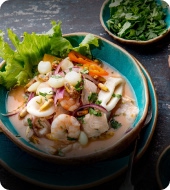
The Treasures of The Lord of Sipan
Written by:Valencia Travel
Last Update: 2025-06-25
One of the most fascinating yet barely-known civilisations of ancient Peru is the Moche, who inhabited the northern coast of Peru between 100 and 700 AD and whose remnants can be visited on a tour from Chiclayo to Trujillo. The Moche dominated northern Peru the first seven centuries of the so-called “common era.” Sican civilization rose after the end of the Moche/Mochica era and lasted until the conquest by Chimus. The Museo Tumbas Reales de Sipan (Royal Tombs Museum), opened in 2002 displays what was found in three royal tombs in Huaca Rajada.
Huaca Rajada
Moche Civilization
These tombs from the Moche civilization, known for its ornamental pottery and fine metalwork, were the home to the impressive treasures excavated in the Huaca Rajada, a Moche adobe temple discovered in 1987. The most extravagant funerary objects were found in the tomb, which is now filled with replicas placed exactly where the originals, which are currently on permanent display in the Museo Tumbas Reales de Sipán in Lambayeque.
Sr de Sipan
The archaeologist Walter Alva
The archaeologist Walter Alva and those working with him carefully excavated the crypt of a ruler dubbed the Lord of Sipan (El Senor de Sipan) in 1987. Found just 11 km north of Chiclayo in the town of Lambayeque, the Museo Nacional Tumbas Reales de Sipán is a true highlight along the Moche Route and a wonderful example of off-the-beaten-track travel in Peru. This site is the home to the impressive treasures excavated in the Huaca Rajada. This museum is even more impressive than those in Lima with its unique collection of Moche artifacts. The artifacts were uncovered in the tomb of El Señor de Sipán, a Moche leader who was buried with an extravagant collection of gold, including ornamental breastplates and a golden staff known as El Cetro Cuchillo. The museum also displays spectacular necklaces made from Spondylus shells– some of which weigh up to six kilos, which were excavated alongside this important ruler and have since been patiently restored by experts.
Moche Mask
The Moche Route
Our Moche Route tour from Chiclayo to Trujillo will also take you to other fascinating and important archaeological sites, such as “El Brujo”, which spanned across a number of different civilisations including the Moche. The site is home to the Huaca Cao Viejo and The Haca Cortada, other remnants of ancient Peruvian civilisations and thought to be one of the female Moche leaders of the time. The Señora de Cao Museum houses here mummified remains, along with the valuable artifacts that accompanied her.
El Brujo Archaeological Site
 Aventure
Aventure
 Cultural
Cultural
 Gastronomy
Gastronomy
 Wellness
Wellness
 Local Living
Local Living
 Luxury
Luxury












